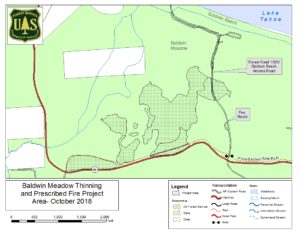Meadow Restoration Work Underway Near Baldwin Beach
Tahoe Chamber | October 12, 2018 | Community News • Press Releases
Share This
SOUTH LAKE TAHOE, Calif. – The U.S. Forest Service Lake Tahoe Basin Management Unit (LTBMU) resumed meadow restoration work last week in Baldwin Meadow, which lies just south of Baldwin Beach on the south end of Lake Tahoe. The restoration work at Baldwin Meadow includes thinning conifer trees (white fir, lodgepole pine, incense cedar and Jeffrey pine) that are encroaching into the meadow and prescribed fire operations (understory burning) in the meadow itself. Mechanical fuels reduction work, also known as forest thinning, is expected to take place over the next several weeks, with prescribed fire operations expected to begin in mid-October, weather permitting.
“With this year, we have seen the largest wildfires in both California and Nevada history,” commented Jeff Marsolais, LTBMU Forest Supervisor. “So it is more critical than ever that we increase the pace and scale of our forest restoration work.”
Healthy meadows are essential to the clarity of the Lake Tahoe watershed. They filter fine sediment from water flowing into Lake Tahoe and provide essential habitat for diverse plant and animal species. Meadows are also valued for their scenic qualities as they are often close to recreational facilities, such as trails, beaches and campgrounds.
This meadow restoration work is being carried out under three existing LTBMU projects. The first is the South Shore Healthy Forest and Fuels Reduction Project, which emphasizes thinning trees in order to improve and maintain forest health and resiliency to wildland fire, drought, insects and disease. The second is the Restoration of Fire Adapted Ecosystems Project, which provides a significant ecological benefit to the Lake Tahoe watershed by restoring six impaired meadows in the Tahoe Basin and strengthening their resiliency to climate change impacts to prepare them for future natural disturbances. The third is the Aspen Community Restoration Project, which identified aspen as an ecologically significant species that provides tremendous value for wildlife, soil processes, landscape character and recreational viewing opportunities. Aspen also provide a historical value as aspen carvings on trees located in the basin represent over a century of history about past cultures in the area.
“The Forest Service has tailored our management strategy in this area to restore sensitive and rare habitats like meadows and aspen stands,” said LTBMU Wildlife Biologist, Stephanie Coppeto. “For example, in Baldwin Meadow these thinning treatments and prescribed fire operations are expected to help preserve the recent meadow restoration, which was conducted under the Restoration of Fire Adapted Ecosystems Project.” During this meadow restoration, the LTBMU thinned trees that had invaded the meadow and replaced native meadow plants. By thinning additional trees and using prescribed fire, the LTBMU anticipates seeing a rebound in the establishment of native meadow plants including wildflowers.
This combined restoration effort also includes thinning conifer trees from the iconic aspen stands near the Pope-Baldwin Bike Path along SR Highway 89. “These aspen not only serve as a beautiful backdrop to fall walks on the trail, but these aspen ecosystems support many native animals,” said Coppeto. “The aspen are being lost as conifers grow denser and higher into the canopy, which takes up precious space that the aspen need to survive and thrive. This restoration effort is expected to thin those trees that are threatening the continued survival of these aspen stands.”
This project will also include a prescribed fire component called understory burning. Understory burning is low intensity prescribed fire that takes place on the ground (the understory) rather than pile burning. Low intensity fire is a natural process in the Sierra Nevada ecosystem that provides important benefits to forest and meadow habitat, which in turn provides essential habitat for diverse plant and animal species as well as community protection by removing excess vegetation that can feed wildfires.
Baldwin Meadow is approximately 121 acres in the Tallac Creek watershed and 86 acres is targeted for prescribed understory burning over several weeks depending on staffing and weather conditions.
The prescribed understory burning may require closure of some trails to pedestrians and bicycles in the Baldwin Beach area, but work is expected to begin after Baldwin Beach closes for the season on October 14, 2018. Trail closure notices will be posted in the area and on our website and social media pages at www.fs.usda.gov/ltbmu, https://www.facebook.com/LakeTahoeUSFS/ and https://twitter.com/LakeTahoeUSFS.
Prior to the prescribed fire component, LTBMU fire management staff prepare a burn plan that includes a smoke management plan and close coordination with the El Dorado County Air Quality Management District, the agency who issues the burn permit. Before burning, they wait for favorable conditions that will carry smoke up and disperse it away from smoke sensitive areas. Crews also conduct test burns before igniting larger areas, to verify how effectively vegetation is consumed and how smoke will travel.
When conditions meet the prescription, a burn permit is issued allowing operations to proceed. Smoke from prescribed fire operations is normal and may continue for several days after an ignition.
Prescribed fire smoke is generally less intense and of much shorter duration than smoke produced by a wildland fire. Smoke sensitive individuals are encouraged to reduce their exposure by staying indoors if they are in a smoke affected area. Learn more about smoke management tips at https://airnow.gov/air-quality-and-health/fires-and-your-health.
Before the prescribed understory burning begins, the Forest Service will post road signs around the affected area, send email notifications and update the local fire information line at 530-543-2816. To receive prescribed fire notifications, send an email to pa_ltbmu@fs.fed.us.
For more information on these projects, visit http://www.fs.usda.gov/goto/ltbmu/SouthShoreFuelReduction, http://www.fs.usda.gov/goto/ltbmu/FireAdaptedEcosystems and http://www.fs.usda.gov/goto/ltbmu/AspenRestoration.

